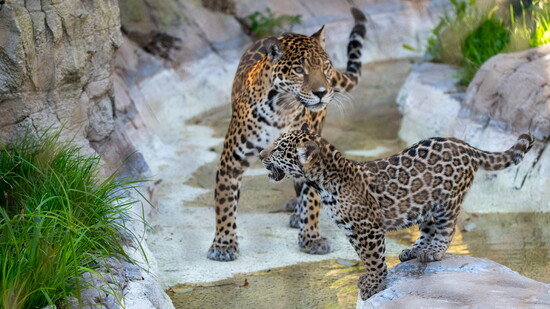On the edge of downtown in the early 1900s, the historic Kellum-Noble house, built in 1847, was home to Houston’s first zoo—a collection of rabbits, black bears, capuchin monkeys, prairie dogs, and more.
In 1920, a bison named Earl—donated by the federal government—joined the growing collection of animals, leading Houstonians to begin earnestly talking about expanding the zoo. In 1921, the City purchased an assortment of snakes, birds, and alligators to accompany Earl and his fellow animals, and in 1922, erected a fence around a tract of land in Hermann Park to house the burgeoning collection. The City's first zookeeper, Hans Nagel, cared for just 40 animals. But that beginning has since grown to more than 6,000 animal residents, more than 600 different species.
“In 1922, the Houston Zoo was proclaimed a reality,” says Lisa Peterson, Houston Zoo President and CEO. “This small fence grew, grew some more, moved to Hermann Drive, and 103 years later, it is now the 55-acre paradise of today. What all began with Earl has made Houston Zoo a leader in the global movement to save wildlife.”
Houstonians Remember the Zoo
Visiting the Houston Zoo as a grandmother recently brought back a flood of childhood memories. My cousins Donna and Vicki McCallum enjoyed riding the train and watching the seals and sea lions while I was still in a stroller.
On my recent visit, I was encouraged to see the landscapers preserved the vintage lion water fountain with his mouth open, as well as the elephant water fountain with the ball on his nose—recollections from my childhood.
Cathy Fosdick Fitzpatrick Cleary, wife to Houston Zoo's Chairman of the Board, Joe Cleary, remembers that era of the zoo, too.
“My fondest and earliest memories of visiting the Houston Zoo began in the late 50s,” says Cleary. “Animals are no longer in small cages like I remembered."
By 1925, zookeeper Nagel had become Zoo Director, and the zoo's animal population had grown to 400 animals led by Asian elephants Nellie and Hans. By 1938, the Zoo represented an investment of $50,000—roughly equivalent to $750,000 by today’s standards. Then, in the immediate post-World War II era from 1950-1960, the Zoo added the Reptile House, bear, large cats, and giraffe exhibits. In those days, the zoo's neighbors could hear the distinctive meows of peacocks at night.
Shirley Grunert, part of the Assistance League of Houston, recalls wild memories of volunteering with the rapidly growing zoo—including a snake on the loose.
“We would take smaller animals in cages to elementary schools for visits," says Grunert. "A friend of mine pulled into a gas station—back when attendants pumped gas and washed windshields—and he asked, 'How may I help you?' She replied, 'You can help me get this boa constrictor back in the cage.'”
The Zoo Yesterday
Perhaps the most charming attribute of the zoo is the romances that have blossomed through its 103-year history. Erica Rose Sanders, daughter of renowned silhouette artist Cindi Rose, for example, is among those who can say they got engaged at the Houston Zoo. And couples who find amor at 6200 Hermann Park Drive are more numerous than one might think.
The list of animal companions at the Zoo includes radiated tortoises Mr. and Mrs. Pickles, Humboldt penguins Dora (brown) and Queso (blue/yellow), Churro (light green) and Alex (dark green), and Northern white-cheeked gibbons Ting and Max. Not all the pairs have yet mated, like giant river otters Marley and the rugged, muscular Panobo. But they are a bonded pair and may mate someday. Tesoro, the late male jaguar and his lady love, Vida, gave birth to 2.2 lb. baby Rojo, who has become the heartthrob of the entire zoo.
The Zoo's history from 1960 to 1970 saw a revived era of construction and expansion with the construction of the Zoo’s first Children’s Zoo, while the 1980s brought the construction of the Kipp Aquarium and the Denton Cooley Animal Hospital. In 1988, the zoo began charging admission fees, and in 2002, the Houston Zoo entered a new era of non-profit management.
The Zoo Today
The Houston Zoo is the only one in the world to build a major conservation-focused exhibit based on the Galápagos Islands. Doors to the $70 million mysterious Galápagos Islands exhibit near the front of the zoo opened in April 2023, offering visitors a chance to get up close with the famed volcanic archipelago's unique species, including a 40 lb. green sea turtle named Bobby.
The newest project is the Jurassic Giants, replete with 60 life-size prehistoric creatures and interactive digs, here through September 1. It is near the African Forest, a $100 million undertaking that recreates an awe-inspiring wilderness habitat where chimpanzees, rhinos, and giraffes thrive in a spacious environment reminiscent of the forest landscape of western equatorial Africa.
From my recent visit, I can certify that a can't-miss experience is watching Rojo, the now seven-month-old baby jaguar, play in the water while his mother, Vida, naps nearby under the bamboo with her paws up in the air.
The Zoo Tomorrow
Around the zoo, the conservation narratives about every animal explain how they became endangered and how humans intervened to bring them back from extinction.
“The Houston Zoo has grown from my beloved monkey in cramped cages to the number-one conservation education institution in the state of Texas,” says Cleary.
Throughout the over-a-century-old history, from Earl on down to Rojo, the Houston Zoo proves to be one of the city's best-loved attractions. As Simon & Garfunkel sang, "Someone told me it's all happening at the zoo. I do believe it. I do believe it's true."
